Table of contents
- Advice: children as passengers Kids and motorcycle
- A question of responsibility
- A feat of strength for the mini pillion passenger
- Ready for the pillion seat?
- Children and motorcycle
- Children’s clothing
- Helmets
- Tips for tours with children
- interview
- Driving in a carriage with children
- Addresses
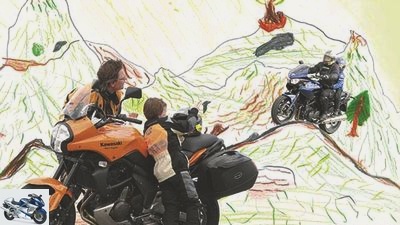
Instead of telly or computer, go outside on a journey together!
motorcycles
Advice: children as passengers
Advice: children as passengers
Kids and motorcycle
Instead of telly or computer, go outside for a ride together! Children can easily get excited about such a program. However, the adults should pay attention to voluntary self-restraint and age ratings for the pillion seat.
Thorsten Dentges
04/22/2009
Gerd Wirz has three daughters. They like to ride a motorcycle. The proud father thinks that’s great and therefore often takes her with him. And all at the same time: the smallest, 1, strapped to the stomach with a belt, the largest, 5, on the pillion seat and the middle, 3, in a child seat mounted on the luggage carrier. When he stops at a motorcycle meeting in the Bergisches Land with his fully occupied Moto Guzzi, a policeman approaches the machine, rubs his eyes, counts the driver and passengers.
The law enforcement officer is outraged by the curious tour group: “Stop, not like that!” The father asks: “Why not?” The policeman argues that the load is exceeded, the braking ability is insufficient and the children cannot be supervised while driving. Wirz countered with a payload of 240 kilograms, a converted manual integral braking system for the Guzzi and an intercom system suitable for four people. The irritated policeman now has no words and dismisses the troops with the request: “Then drive carefully.” The daughters are now 18, 20 and 22 years old and drive motorcycles themselves. Wirz sells and rents out motorcycle communication systems full-time Children’s equipment (www.gerdwirz.de).
Buy complete article

Advice: children as passengers
Kids and motorcycle
10 pages) as PDF
€ 2.00
Buy now
As a lot of things change over time, a similar situation would probably end differently today. The text of the law regulates the following in § 61 of the Road Traffic Licensing Regulations (StVZO), in contrast to circulating half-knowledge: “Two-wheeled vehicles on which a passenger may be transported must be equipped with a holding system for passengers (…)” and also “Be equipped with footrests on both sides for the driver and front passenger.” A belt strapped around the waist is not considered a restraint system, and if footrests are only attached for the driver and passenger, the motorcycle is only approved for a maximum of two people. The law also says: “Motorcycles on which a passenger is transported must be equipped with a seat for the passenger. This does not apply when taking a child under the age of seven with you, if a special seat is available for the child and wheel cladding or similarly effective facilities ensure that the child’s feet cannot get caught in the spokes “(StVZO § 35/9).
Gerd Wirz had met these requirements for at least one daughter. Taking children on the motorcycle can also be forbidden if the offspring is assessed as mentally and physically incapable of following what is going on on the two-wheeler. Without a doubt, a one-year-old and even a three-year-old child can hardly stay on the machine on their own, let alone see what is happening in terms of driving dynamics when leaning, braking and accelerating. The policeman who instructed Gerd Wirz at the time would have had enough arguments to stop the journey immediately and to charge the driver with a fine or warning for improper occupation.
A question of responsibility

Artist
“The self-confidence of our four-year-old has multiplied after his first pillion tour.” (Carsten Bender, son gets mini motorcycle)
It gets more complicated when the children are a little older, because there is no catalog with certain skills that a child must meet to ride on the motorcycle. It is the responsibility of the parents to determine from what age their offspring can join. The trip with a preschooler can become a controversy if the assessments of legal guardians and law enforcement are different. MOTORRAD editor Rolf Henniges, for example, prepared the motorcycle tour together with his four-year-old son with great care and care. The multi-day trip went without any complications. Afterwards, when asked for an opinion, the police expressed themselves critically. And experts like Matthias Haasper from the Institute for Two-Wheeler Safety (ifz) in Essen point out: “Small children of preschool age show significant developmental differences and are hardly predictable, I would be very, very careful.”
In general, caution should be the top priority. Even if there are older school children on board who can generally be trusted to express their own sensitivities or fears clearly and who should also be mentally and motorically able to react correctly to situations such as braking. Whereby trust is only one thing, the other way around, the child must be able to trust the driver without restriction. In order to gain this trust, as a driver you shouldn’t think that a small adult is crouching behind you. The short ones often find the parked machine impressive, but as soon as it is in motion, they look at it with completely different eyes. The driving test revealed: The lower and less spectacular the performance and its development, the less sporty the machine appears, the more likely it is to win the hearts of little riders. In the toy store, true-to-scale plastic crackers with lots of colorful racing stickers or blatant enduro bikes are very popular, but they fail in real passenger life. In the form of the gas tap and brake lever, the driver has it in their own hands to avoid scaring off their little passengers. Here the clear recommendation applies: gentler is better.
In fact, children are much more physically challenged than adult passengers. Because of their lower body mass and thinner fat tissue, kids cool off faster and freeze even while the pilot is still feeling very well. You therefore absolutely need adequate motorcycle equipment. The offer is now good, but there is still criticism. Peter Schaudt from TuV Rheinland in Cologne, responsible, among other things, for the homologation of children’s helmets, certifies that adult and youngster helmets achieve comparable shock and impact absorption values according to the test standard. However, it is disadvantageous if a special, significantly less voluminous children’s helmet shell is dispensed with and only padded to a child’s size. Then there is an increased risk of scraping, explains Schaudt.
The bigger problem, however, is the weight: children’s helmets shouldn’t weigh much more than 1000 grams. With full-face helmets, this can almost only be achieved with carbon – too expensive for the price-sensitive children’s equipment market. “I would prefer to put a light open face helmet on my child because every gram counts for this purpose,” explains the TuV expert. It is similarly difficult with CE protectors for clothing, as the test standard is only based on adults. Most of the protectors on offer are not soft enough and respond with a low body weight (less than 30 kilograms) only very delayed when it hits the ground. And that even though they have the coveted test stamp. There are fewer blunders in the functional clothing itself: abrasion-resistant outer fabrics, waterproof climate membranes – just as good as the big ones.
A feat of strength for the mini pillion passenger

Artist
Due to the relaxed seating position, play mobiles receive a lot of sympathy points from young and old.
But even well-wrapped children have to struggle as passengers. In contrast to small self-propelled motorsports (more on this soon in MOTORRAD), the mini-pillion has to twist heavily in order to hear the traffic in front of him. That takes strength. The neck and neck muscles, which are still poorly developed, are particularly stressed – if only by the airstream. In addition, the head weighs disproportionately more to the rest of the body in children than in adults. If the weight of the helmet is added, then, depending on the constitution of the offspring, overload reactions are programmed after a certain period of time. And the mind is not always willing in a passive position either. “The stamina of children is less, so the driver should make sure regularly whether the young passenger is still involved,” appeals the sports medicine specialist Dr. Norbert Beil from Bunde and points out that the ability to ride a car can basically be trained through motor skills and coordination exercises. “In short: sporty children are more likely to be allowed to ride a motorcycle,” explains Beil.
Now it is right to question whether a child has anything to do with a motorcycle at all. Because unlike in a car, there is no body, seat belt or airbag to protect you in the event of an accident. No ifs or buts: the risks and dangers are proportionally greater. However, figures from the Federal Statistical Office show that the number of fatally or seriously injured pillion children is low. In 2007, two children under the age of 15 died in moped and motorcycle accidents in Germany, and the same number of children died as passengers on an agricultural machine. In car accidents, the number is over ten times higher. However, of the roughly eleven million children up to 15 years of age who live in Germany, the majority occasionally or regularly drive in the car, in contrast to the cautiously estimated 15,000 motorcycle riders under 15 years of age. A total of 36 children succumbed to their injuries while driving themselves in bicycle accidents. As tragic as the accidents are, they happen.
Many parents certainly use a motorized two-wheeler, preferably a smaller city scooter, as a means of transport to school or kindergarten with all the advantages: economical, no parking problems, more environmentally friendly than a car. Most trips on the motorcycle are purely recreational, so the fun must be weighed against the health risk. A sidelong glance at other leisure activities is helpful for the risk assessment: estimates by the relevant sports associations or insurance companies assume that skiing (several hundred thousand active children) and sailing (according to the German Sailing Association, around 30,000 members of the “sailing youth”) also on average one to two fatal accidents occur every year. With around 200,000 riders under the age of 14, the number of victims is slightly higher. “Like a motorcycle, the horse is often an unpredictable factor for children”, explains David Schulz, specialist in sports accidents at the insurance company Arag in Dusseldorf, and compares the accidents between riders and motorcycle riders: “Fortunately, there are few accidents with children, but when they do, the consequences are usually very severe.”
Ready for the pillion seat?
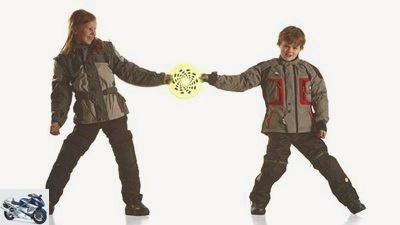
Artist
“It only makes sense to take small children with you on a few motorcycles. First and foremost, the parents’ ambition and ego are being pushed.” (Manfred Rzadca, has already taken his children with him on different machines)
Although the number of small passengers is in the five-digit range, there is no lobby of any kind. While dedicated forums and communities are now being formed on the Internet for almost every motorcycle model, there is no special children’s forum, but only individual posts and topics on websites that are primarily of interest to touring riders. Children on motorcycles – this is a very controversial topic within the motorcycle community as well, as many readers’ letters show. The tenor: take away, yes, but only when the children are mature enough and express their wishes themselves. And actually only if the driver’s own needs are less important than those of the child. Those who come out when driving with children in their luggage, however, unanimously leave the impression that they are aware of the risk and therefore drive with the child on board particularly carefully and carefully.
And although it can be assumed that Gerd Wirz was always very caring with his three little daughters, social acceptance does not promote such actions any more than any accident – regardless of whether it was their own fault or not. Finally, the question arises as to where the gain is to take children with you on a motorcycle, because it is hardly any fun to drive. There is no binding answer. Maybe it doesn’t have to exist at all, because gut instinct helps sometimes. Just close your eyes and remember: What was it like when you stood in front of a machine for the first time as a boy or girl? How when you sat down on it for the first time? And do you remember the childlike joy on your first trip, even if you were an adult long ago? Let the thoughts work. – You are now at the level of a child who would like to ride with you.
Children and motorcycle
Neither the manufacturers advertise certain motorcycles as “particularly child-friendly”, nor have there been special test criteria for the transport of children at MOTORRAD. Understandable, because hardly anyone will choose a machine according to their child’s ideas. It is still exciting to see which type of motorcycle is in the favor of the little ones and who fails. What can you go on a big tour with, and which machine would be cool to be picked up from school with? At Motorcorner in Wangen (www.motorcorner.de) there were kindly six models of different types available for the big and small testers. So, let’s go for a test drive!
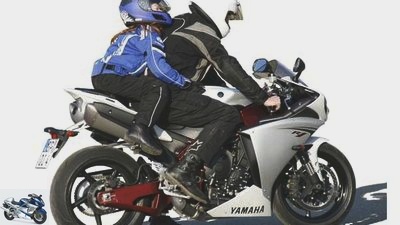
Artist
A mini pillion does not like to befriend a super sports car.
Super sport
“The machine is completely stupid, I always slide forward and off the seat cushion, it hurts. And I was afraid of falling down the whole time ”- thoroughbred sports machines like the radical R1 are met with harsh criticism from the eight-year-old riders. No, this is definitely not a device for child transport. The high seat and the high footrests, which are easily accessible even for very short legs, are only child-friendly at first glance. The kids are literally glued to the driver’s neck, except for the pilot’s jacket. Pronounced vibrations in particular cause complaints. Peak performances of around 180 PS want to be kept in check and generate stress hormones even for solo drivers who are experienced in sports – with a small passenger on board, it is only advisable to be overly cautious just above idle. It’s really no fun in the “ready-to-race” sitting position.
Conclusion: tears and bitter curses after the test drive. Please only take the shortest route to the nearby ice cream parlor!
All-round
All-rounders like a Yamaha XJ6 do not show off their top performance, are unobtrusive and therefore perhaps less attractive from the point of view of some motorcyclists. Another characteristic is that they are hardly outstanding, but can do a little bit of everything. And that little bit is more than enough for children. The biggest advantage: With the smooth power delivery, the driver does not have to constantly pay attention to whether everything is still in place in row two. The compact dimensions of these motorcycles are not only appreciated by the youngsters when getting on and off, for example, maneuvers with children in front of school are also easier for the driver. Huge praise for the straight bench on which the child does not slide forward. And even the mostly conventional look is judged positively by the short ones. Just as hissing tigers, scowling crocodiles or raging monkeys are the hit in the zoo for children, but a cute hamster is probably more acceptable as a pet, they obviously prefer motorcycles that are also tame in the wild.
Conclusion: After a completely stress-free test round, everyone was overwhelmed by enthusiasm. Average can be so beautiful.
Fun
Fun devices like the KTM 990 SMT convey the temperament of a super athlete, but in contrast to them do not instill fear. In particular, the upright seating position conveys the crucial feeling of security that is essential for young passengers. Stronger vibrations and load change reactions are then even perceived as “fun like being on a trampoline”. The drivers appreciate good lean angle stability, and this ensures that the passengers also go actively into the curve after a short period of getting used to. Similar to super athletes, however, the leadership potential of such machines cannot even begin to be experienced with the offspring behind them. So there is always this “I want, I could – but I am not allowed” feeling. And even if classic fans are now clapping their hands over their heads, the fun bike is the best in the schoolyard rating: plastic, jagged future design, angry look – this is what a Playmobil looks like, which not only many fathers but also youngsters like.
Conclusion: Due to the relaxed seating position, play mobiles receive a lot of sympathy points from young and old.
Cruising
Comfortable, but also a bit boring for those who are more sporty. However, if you have a child as a passenger, you don’t have to worry about too little dynamism. Running boards that touch down early, lack of breath at higher speeds and a passive sofa sitting posture are very effective limiters for any cockiness in real cruisers like the Yamaha XVS 950. Both day trippers get their money’s worth: the pilot can calmly maintain the solo driving style, the child sits comfortably and upright, can look forward, left and right. In this way, the short ones get a lot of the driving action, and longer stages are much more relaxed for everyone involved. The low seating position makes it easy to get on and off, and the greater proximity to the ground creates a good, safe driving experience for the little ones, so that even a stronger pull on the gas tap is not punished with protest. Accordingly, it is surprisingly not as boring for sporty-minded drivers as they feared in advance. And although the manufacturers are certainly targeting a much older target group with the XVS 950, the kids find the cruiser much cooler than the hot super sports sweeper and ask: “Dad, can you pick me up from school with this full, long and very low thing? “
Conclusion: Because of the old boys’ league! The young people could choose and already had a driver’s license, the cruiser would be a real winner for them.
Enduro
Offroad? It’s best to forget it right away, as neither adolescent nor adult rear-seaters find that fun. Patchy country lanes are also a good area for enduro bikes like the XT 660 Z Tenere. There, away from heavy traffic, the fun factor is greater with small passengers, after all, off-road machines are ideally equipped for any type of bump due to a lot of suspension travel. And the little ones come out big sitting high, even have the cockpit in their field of vision (“Dad, you drove 91, 96, 98, 92, I saw it exactly!”). Whether this type of control is desired is something that men or women have to judge on the handlebars for themselves; good vehicle control through moderate power, low weight and a wide handlebar is undoubtedly an advantage with child cargo. In practice, however, there are already problems when climbing, because climbing the pillion’s throne is a gymnastics act – failure is perceived as embarrassing (deductions in the schoolyard rating!) The bonsai test drivers also complained about the single-cylinder machine that everything was very “vibrating”, and the “tilted” feeling in curves (high center of gravity typical of the genre) was also perceived as rather annoying. The advantages and disadvantages of a shirt-sleeved Enduro outweigh each other, and this type of motorcycle is only partially suitable for relaxed driving with children.
Conclusion: Away from asphalt already taboo, an Enduro on the road leaves the passengers with mixed feelings.
Touring
A luggage system fenced off the pillion passenger – this creates a great sense of security, even when cornering a little briskly. “That is really nice and pleasant”, say the little test drivers and find that there is no “falling feeling” because of the suitcase. They praise the comfortable pillion seat: “So comfortable that I almost fell asleep.” The look? Well, they don’t necessarily want to be picked up from the schoolyard with it – “looks kind of stupid with the boxes on the side and also a bit boring”. Big drivers and small passengers agree, however: a motorcycle like the Sprint ST is ideal for trips to the countryside. This means that everyone and every child can move forward quickly, and in comfort mode at all times.
Conclusion: a direct hit! Runs like on rails, is comfortable – top marks while driving. However, such a machine is left behind when parked.
Children’s clothing
Good news: In recent years, a lot has happened for children in terms of helmet and motorcycle equipment. Larger selection, better quality, denser network of shopping opportunities ?? and fair prices. Apparently the manufacturers have discovered this customer group for themselves. Less suitable, although very popular, are extremely inexpensive racestyle jackets that only meet fashionable requirements. In general, however, children’s equipment is nowadays at a good level in terms of safety and weather protection. MOTORRAD presents some recommended products that can also be worn for other outdoor activities and winter sports. A list of suppliers provides an overview of the market.
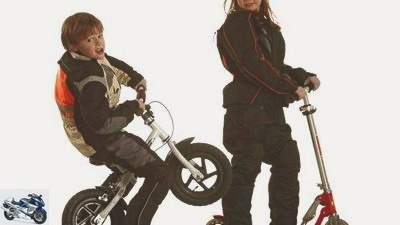
Artist
Left: Chili AX from Difi; Jacket EUR 129.95, trousers EUR 99.95. Right: Modeka T-5; Jacket 62.50 euros, trousers 55 euros.
Boots have to sit comfortably, because if there is pressure somewhere later, the journey home is usually very soon. Practical leisure boots such as the City Limit from Buse offer better protection than airy trainers thanks to integrated ankle protection, but full-fledged leather motorcycle boots such as the exemplary Drive Youngster from Polo (59.90 euros) with a stiff, high shaft and shin reinforcement are more recommended . The range of good motorcycle boots in children’s sizes from 30 is still very thin. When getting dressed, the little ones usually need help to close the boots properly and to stow them properly under the trousers.
gloves made of leather such as the high-quality Kids Race sports glove from Held (49.95 euros) or the inexpensive Randy junior from BF Hardwear (24.90 euros) offer hardly any weather protection, but more safety than waterproof textile gloves such as the Drive from Polo (26, 95 euros) or the Probiker PR-1 junior from Louis (bottom right, 19.95 euros). A common problem with the more versatile textile gloves is the inner lining slipping – putting them on becomes a test of patience.
J.R. Buse kids (Jacket 89.90 euros, pants 79.90 euros). Light, uncomplicated combination (from size 116 on offer) made of abrasion-resistant polyamide fabric and proven Reissa climate membrane. The jacket in bright blue or orange appeals to the children’s sense of style, as does the fit. There are deductions for the hardly protective foam padding. After all, a complete set of CE protectors from Sas-Tec (www.sas-tec.de) can be retrofitted for around 40 euros – highly recommended! Good: ventilation options in the chest and back area, adjustment options at the waist, sleeves and ankles, as well as anti-slip material on the seat.
Marvin / Simba from Ixs (Jacket 99.90 euros, trousers 75 euros). Combination with well thought-out adjustment options and robust outer fabrics. The quality is absolutely flawless and the workmanship is clean and can be passed on to younger siblings even after frequent use. The price is fair, but just like the Buse station wagon, the downside is that CE protectors are not included in the scope of delivery. Ixs has matching protectors for plugging in for a total of 86 euros. The well-fitting Simba trousers with stretch material on the rump and knees are available from size 110 (jacket only from 122).
Helmets
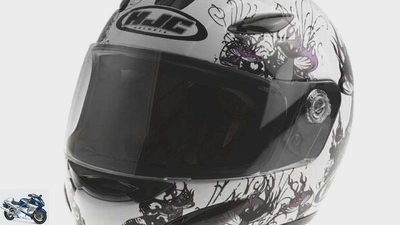
Artist
HJC CL-14Y Mush, 109.99 euros.
HJC CL-14Y Mush
Quality, equipment and ventilation very neat; Thermoplastic, sizes 50 and 52, weight 1300 grams, 109.99 euros.
Nexo Junior
Extremely cheap, but also comparatively heavy and cheaply made with poor air inlets, helmet shell for a children’s helmet is very voluminous; Thermoplast, sizes XXS to S (5156 cm), weight 1400 grams, 59.90 euros.
Marushin 111 Kids
Exemplarily delicate, well-made helmet, comparatively light, grows with the child thanks to three cushions of different sizes supplied, unpleasant internal odor; Thermoplastic, sizes XXS to S (52–56 cm), weight 1150 grams, 119 euros.
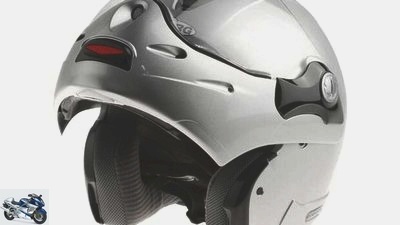
Artist
Caberg Rhyno Mini, 149.90 euros.
Hero cartoon
Inexpensive fiberglass-kevlar helmet, weight information different from the other helmets in comparison is an understatement (test specimen weighs 1300 grams), moderate ventilation; Duroplast, sizes XXXS to XS (50–54 cm), weight 1150 grams, 99.95 euros.
Caberg Rhyno Mini
Not a lightweight, but as a flip-up helmet a good compromise between full-face helmets, which are often perceived as cramping, and airy jet helmets; Thermoplastic, sizes XXXS to S (49 to 56 cm), weight 1350 grams, 149.90 euros.
Fox V1 Kid: light, but should be worn with cross-glasses, inner lining removable; Thermoplastic sizes 47 to 52, weight 1100 grams, 149.95 euros.
NZI Single Jr: designed for trial sports, safety and weather protection restricted to road machines, extremely light, also approved as a ski helmet; Thermoplastic, sizes S and L (50–53 cm), weight 750 grams, 55 euros.
Tips for tours with children
The responsibility is high and non-transferable. A little guide should help to avoid mistakes and frustration.
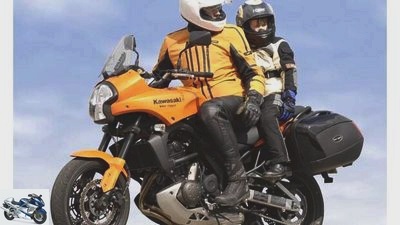
Artist
From kindergarten age onwards, parents can better assess when the short ones are ready for their first motorcycle ride.
3–7 years
Maturity:
Preschool children have limited visual perception and peripheral vision is not comparable to that of adults. They only see the section in front of them and do not notice what is happening to the left and right of them. Younger children only see everything from their perspective. For example, if you look at an approaching car, think that the car is also looking at you and noticing you. At this age, it cannot be assumed that the child will follow the traffic and remain seated on the motorcycle despite prior arrangements. There is also the risk of falling asleep suddenly in the pillion seat.
Before the tour:
Can the child express emotional states with words (“I am tired”, “I am afraid” etc.)? Does it understand agreed-upon signs (such as a knock on the driver’s thigh)? In the bicycle seat, the child should remain seated for more than 30 minutes while cycling and be so fit in terms of motor skills that cycling for example does not cause any problems. Carry out a small “helmet test”: Place the child on a bed so that shoulders are on top, head (with helmet) and neck hang freely. If the child has problems holding their head for at least 30 seconds, the helmet is still too heavy. Better to stay at home then.
Traveling:
Initially just do “parking laps”, then go on mini tours (5 to 10 minutes) on small side streets with little traffic and low speed (30 to 60 km / h). If it works well, don’t drive for more than 15 minutes at a time. The child’s attention should be checked every few minutes by means of agreed signals – ideally: through a communication system. If the confirmation symbol is missing, end the tour immediately.
8-11 years
Maturity:
As a rule, elementary school students should have learned to sit still for a long time (the motorbike remains taboo for a fidgety man) and be mature enough to be able to express themselves verbally. However, they are only “suitable for tours” to a limited extent. The driver must not overlook supposedly strange sensitivities, for example. The hearing ability, for example, is only fully developed from around the age of twelve, before that children cannot precisely locate sounds. The child perceives the engine noise differently and, in contrast to the driver, can also find it annoying. Likewise, a helmet for children of this age is often still felt to be very restrictive.
Before the tour:
Bicycles, kickboards or inline skates are fun for the child. Basic technical issues have been clarified (exhaust becomes hot, vibrations come from the engine). The child can roughly explain what happens when braking and accelerating and demonstrate single-lane driving dynamics (simulating inclines on a small chair). Helmet and clothing should be able to be put on independently – the driver still has to check that they are correctly fitted. Agree on signs and play through them, discuss interesting tour destinations (ice cream parlor, playground, wildlife park) together. Asking a “trick question” to determine how great the desire for motorcycling actually is: “Wouldn’t we rather go there by car?” If the motorcycle remains the first choice, let’s go.
Traveling:
Take a break every 15 to 20 minutes, total travel time no more than an hour per round trip (if you have experienced passengers, extend it as you feel). Do not choose any demanding routes, a clear view to the left and right is better than narrow-looking forest crossings. Relaxed country road cruising (below 100 km / h) without many gear changes takes the little passengers away from physical and mental stress. Important: During the break, briefly recapitulate what has happened so far, ask what was good and bad and what else was noticed. So the little pillion feels taken seriously.
12-15 years
Maturity:
Admittedly, teenagers are only able to concentrate fully from around the age of 14, but as passengers, many of them have the necessary maturity for longer tours – physically and mentally. You can abstract processes and are able to go through dangerous situations in your head. In this “Sturm und Drang” age, the only problematic are rebellious passengers who deliberately ignore the driver’s announcements or who boycott a continuation of the journey. Even if the youngsters consciously seek dangers and tests of courage elsewhere at this stage of development, this does not apply to the journey as a pillion rider.
Before the tour:
To what extent does the adult driver only transfer his enthusiasm to the young person? Even if the passenger is a persistent sports ace, as a passenger he may not feel much “in the mood” for an hour-long passive position. This should be clarified in an open conversation, just like the course of the planned excursion or even the trip. Also go through typical dangerous situations in theory beforehand (for example, explain the right behavior if the curve closes unexpectedly). As for smaller passengers, the same applies to older children and young people: their wishes are commands, and no means no.
Traveling:
Full-day and multi-day tours are no longer a problem – if requested by the passenger. Bare motorway stretches should still be avoided. Teenagers usually have enough strength and can hold out for a longer period of time similarly or sometimes even better than many adults. Varied routes with swinging curves are the first choice, they keep the young pillion more motivated. Nevertheless, do not forget regular breaks with enough drinking and eating, otherwise the ability to concentrate and the necessary body tension will evaporate. No marathon competitions, otherwise the tour will quickly become an ordeal!
interview
Prof. Dr. Maria Limbourg, University of Duisburg-Essen, expert for preschool and school mobility and traffic education and psychology
? Child on a motorcycle – what does the expert advise?
! Research has shown that riding a motorcycle as a pillion passenger is extremely stressful for children. A passenger is not allowed to dream, but children find that difficult. They are spontaneous and unpredictable, and parents often overestimate their children. The question is whether parents can bear this risk.
? If I take my children with me to ski, for example, they are also exposed to dangers.
! True, but the children themselves are active here. When driving, however, the brain has little to do, the child is easily distracted. If, for example, something tickles the nose or a horse jumps in the pasture, then that is more important for the moment than holding on to the motorcycle. In contrast, driving mini-motorcycles on closed-off routes is extremely exciting, the children are fully involved and react appropriately in the event of danger. Riding is more dangerous.
? But now some motorcycle-riding parents will be disappointed…
! Please note that children’s brains are in the process of maturation. As a result, you are only able to a limited extent to correctly assess dangers. People are only able to concentrate fully from the age of around 14, and in individual cases 12-year-olds can do it. At this age, adolescents are able to understand dangers and processes in an abstract way. If the driver and passengers can already agree on possible dangers on a theoretical level, then I have no concerns.
? The motorcycle is therefore taboo for younger children?
! No, not necessarily. In the sidecar or on a smaller-sized moped, a smaller child is better off, with restrictions it is also possible to ride on the motorcycle. A very big leap in development begins around the age of eight, i.e. at elementary school age. The ability to concentrate improves significantly, as does the risk assessment, and the children are physically fitter overall. Then they will be mature enough to follow what is happening on the motorcycle and actively participate, for example when cornering. If you adjust the ride in such a way that the child does not fall down immediately if you let go of it for a short time, short tours are definitely possible from this age. It is best to bring them up very carefully and observe how the individual child behaves.
Driving in a carriage with children
Around 40,000 motorcycle combinations drive in Germany, many of them with children on board. Certainly the simpler solution if the offspring should be there from an early age. A permanently installed child car seat is advisable in the boat. In sidecars without high side panels, roll-over bars and harness belts, it is better not to fix the child with belts so that – as with solo machines – they land as far away from the machine as possible in the event of an accident. Note: a helmet is mandatory. Further information on driving in a carriage can be found at www.motorrad-gespanne.de or www.gespann-news.de.
Addresses

Artist
Left: Maddox / Nelix von Held, jacket and pants 89.90 euros. Right: Fastness RX Junior / Akito Motion from BF Hardwear; Jacket € 99.90, trousers € 89.90.
Addresses
Suits, gloves, bootsBF
Hardwear Tel. 04421/500166, www.bf-hardwear.de
BMW, Tel. 0180/5001972, www.bmw-motorrad.de
Buse, Tel. 02471/12690, www.buese.com
Cima, Tel. 08234/902363, www.cima-motorradbekleidung.de
Daytona, Tel. 08721/96440, www.daytona.de
Difi via Motoport, Tel. 04451/915200, www.motoport.de
Held, Tel. 08321/66460, www.held.de
Ixs, Tel. 07631/18040, www.ixs.de
Louis, Tel. 040/73419360, www.louis.de
Fashion label. 02521/850322, www.modeka.de
Polo, 02165/8440400, www.polo-motorrad.de
Orina, Tel. 02403/99660, www.orina.de
Off-road equipment
Sinisalo, via ZupinTel. 08669/848500, www.zupin.de
Fox, via Yoko Sports, Tel. 02735/1600, www.fox-germany.de
child seat
Stamatakis, Tel. 0931/415557, www.stamatakis.de
Helmets
Caberg, Tel. 08191/971221, www.caberg-helm.com
HJC, Tel. 02131/523560, www.hjc-germany.deIxs
Probiker, about Louis, see left
Marushin, Tel. 06002/91030, www.jf-motosport.de
Nexo, about Polo, see left
NZI, Tel. 07162/931544, www.jochen-bader-motorsport.de
Rocc, about Buse
Romer, via Roleff, Tel. 02761/929307, www.roleff.de
Vemar, 07432/220595, www.haveba.de
Related articles
-
How it works: tours with children
archive counselor workshop How it works: tours with children That’s how it’s done Tours with children When dad comes back beaming with joy on a Saturday…
-
to travel Traveling with children Traveling with children Children of men Traveling with children is not an easy thing for motorcycle parents. But…
-
fact counselor Used purchase Used advice muscle bikes BMW K 1200 R, HD V-Rod, Triumph Rocket III, Yamaha MT-01 Used advice muscle bikes “Waste your life…
-
archive counselor Used purchase Used advice luxury tourers Second hand advice on luxury touring motorcycles Between 7,000 and 10,000 euros Oscar Wilde…
-
Honda counselor Used purchase Used advice Honda CBF 500 Used advice Honda CBF 500 More than a driving school bike In the ranking of the most…
-
ADAC E-Kids Cup – electric trial competition series for children
Jorg Kunstle Sports & scene Motorsport ADAC E-Kids Cup – electric trial competition series for children ADAC E-Kids Cup for young trial riders…
-
Second-hand advice: Yamaha FJR 1300
manufacturer counselor Used purchase Second-hand advice: Yamaha FJR 1300 Second hand advice Yamaha FJR 1300 (2001 – 2011) The top tourer from Yamaha…
-
Second-hand advice: ABS bikes up to 4000 euros
Jahn counselor Used purchase Second-hand advice: ABS bikes up to 4000 euros Second-hand advice: ABS bikes up to 4000 euros Cheap ABS bikes Most want it,…
-
Artist counselor Used purchase Second-hand advice Second-hand advice on supermotos and funduros Young and with a few kilometers Out of the way! Even the…
-
fact clothing Station wagons, jackets & pants Children on the motorcycle Children on the motorcycle Kid stuff Can the child go on a motorcycle? A…